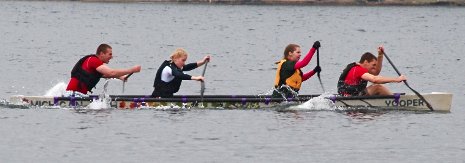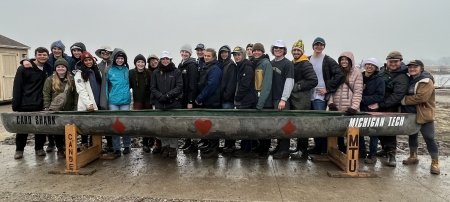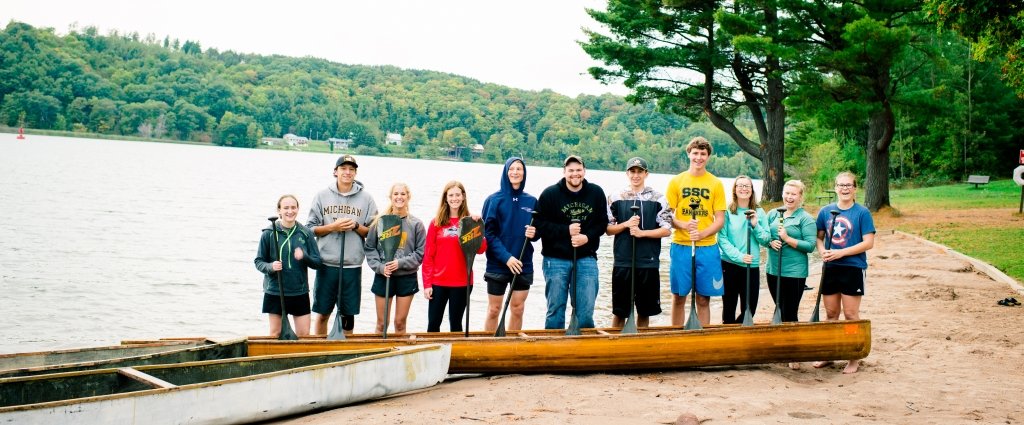Tech Concrete Canoe Team Floats to the Top in Regional Contest

Michigan Technological University paddled the competition at the 2010 American Society of Civil Engineers North-Central Regional Concrete Canoe contest, held March 26-28 at Western Michigan University, in Kalamazoo.
The team took first place in three of the competition’s four categories, paper, display and racing, and finished second in the presentation.
“They were pretty close to perfect,” said their advisor, graduate student Bill Baxandall. “They received no deductions at all, except on the presentation.”
In particular, the team shined in the racing. “We placed first in all the races, men’s sprint, women’s sprint, men’s endurance, women’s endurance and coed sprint,” said co-captain Jon Zalud.
The women’s team not only beat all of the other female entries in all races, they beat all the male teams in the endurance race except Tech’s as well. “They were very coordinated and really work as a team,” said Baxandall.
Zalud credited practice for their performance. “In the fall, we were out on the Portage three times a week, and once the ice comes in, around Thanksgiving, we paddle around the pool in the SDC,” he said. All told, the team logged about 1,500 hours practicing in regular canoes before they put their concrete model in the water.
Work began on the canoe last fall. When ASCE issued the rules requiring a standardized hull design, the team had a manufacturer create a foam plastic mold. At six o’clock one morning, the team began to line the mold with three thin layers of custom-made concrete sandwiched together with two layers of carbon fiber. After curing the three-eighths-inch-thick hull for a month, they spent 200 hours sanding it smooth.
Then came the artwork: elaborate designs both inside and out reflecting the canoe’s name, Yooper. “After that, it’s sealed and off to the competition,” said Zalud.
The 20-foot canoe is 31 inches wide and weighs about as much as the average person, 160 pounds. All the canoes must be buoyant enough to pop up to the surface when completely submerged. How do they do that, considering that concrete weighs about 146 pounds a cubic foot and normally sinks handily in water?
“This year, our mix was 53 pounds per cubic foot,” Zalud said. For aggregate, they used glass and ceramic spheres. “The rules require that 50 percent of the aggregate be recycled, but we had 100 percent.”
Their victory qualifies the team to attend the ASCE National Concrete Canoe Competition, to be held June 17-19 at California Polytechnic University, in San Luis Obispo. They aim to win again, but even if they don’t, it’s been a great ride.
“Working with people like this was one of the best experiences I’ve ever had,” Zalud said. “Having a group of people who are willing to come up to a barn and work on a canoe till two in the morning and not pay them anything is amazing … It’s just been great.”
“They are outstanding,” Baxandall agreed. “They represented the University with first-class style at the competition. They are all a credit to Michigan Tech.”
Team leaders and directors are Ryan Hoensheid, senior co-captain; Zalud, junior co-captain; Amanda Malburg, safety director; Lars Leemkuil, mix design; and Katie Zimmerman, aesthetics.
Michigan Technological University is an R1 public research university founded in 1885 in Houghton, and is home to nearly 7,500 students from more than 60 countries around the world. Consistently ranked among the best universities in the country for return on investment, Michigan's flagship technological university offers more than 185 undergraduate and graduate degree programs in science and technology, engineering, computing, forestry, business, health professions, humanities, mathematics, social sciences, and the arts. The rural campus is situated just miles from Lake Superior in Michigan's Upper Peninsula, offering year-round opportunities for outdoor adventure.




Comments